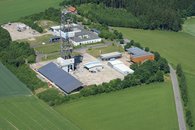The KTB-DL Site
During the KTB project (1987-1995) two deep boreholes were drilled, the so-called pilot hole (KTB-VB, 4 km) and the ultra deep main hole (KTB-HB, 9.1 km). Both wells are nearly completely cased. The VB is accessible to nearly bottom hole. At KTB is the unique constellation of two deep boreholes very close together at one site. The distance at surface between the two wells is only 200 m. figure 1The KTB boreholes are situated in the crystalline metamorphic rocks of a Hercynian continental collision zone. The dominating rock types are paragneisses and metabasites. The rocks experienced at least two Palaeozoic metamorphic cycles and intense post-orogenic crustal stacking during upper Carboniferous and upper Cretaceous. figure 2The boreholes are characterized by generally steeply dipping foliation, >60° and, below 5000 m, strong to extreme borehole wall breakouts. The KTB HB shows very low inclinations (< 2°) down to 7400 m, below the inclination reaches higher values as is in the entire VB (> 5°).figure 3The platforms surrounding the two boreholes are completely paved and therefore accessible also with heavy trucks.figure 4
The pilot borehole VB has a 150 m long open hole section at bottom hole. The 3850 m long section above is cased. Casing and cementation reliably separate hydraulically the open hole section from the above section.
Technical specifications of the KTB-VB pilot borehole: (see also figure 5)
total depth: 4000.1 m
currently accessible depth: 3970 m
cased hole section: 0 - 3850 m
open hole section: 3850 m - bottom hole
latitude: 49° 48.98' N
longitude: 12° 7.16' E
elevation above sea level: 513.4 m
mud weight (rock fluid & water): ≈ 1020 kg/m3
pressure at BH: ≈ 40 MPa
temperature at BH: 120°C (248°F)
temperature gradient: ≈ 28 K/km
maximum hole inclination: 11.5° at 1065 m
drilling time: 18-SEP-1987 - 04-APR-1989, 560 days
The main borehole, HB, offers unique opportunities to carry out technical operations and geoscientific experiments in-situ at ultra great depths and extreme temperature and pressure conditions. There is no open hole section in the HB accessible with sondes. Sondes can be run downto to a maximum of 6700 m. Below there is a lost sonde with logging cable, prohibiting any deeper sonde runs.
Technical specifications of the KTB-HB main borehole:
(see also figure 5 and figure 6)
total depth: 9101m
currently accessible depth: 6700 m
cased hole section: 0 - 9031m
open hole section: 9031m - bottom hole
latitude: 49° 48' 58.8" N
longitude: 12° 07' 19.2" E
elevation above sea level: 513.8 m
mud weight (rock fluid & water): ≈ 1020 kg/m3
pressure at BH: ≈ 91 MPa
maximum recorded temperature: 256°C (493°F) at 9070 m
calculated temperature at BH: 265°C (509°F)
temperature gradient: ≈ 28 K/km
maximum hole inclination: 20° at 8647 m
drilling time: 06-OCT-1990 - 12-OCT-1994, 1468 days
Experiments and tests inside the unique KTB-DL boreholes can be performed under very favorable logistical conditions. Because there is no more rig time to be considered, even long-term experiments may be carried out at low costs.
Facilities needed for standard logging operations are provided by GFZ. The logging infrastructure comprises two logging winches, logging sondes, diverse cable heads & cross-overs, and a complete workshop specialized for logging sonde . The two available winches bear 7-conductor logging cables with length of 3600 m and 4500 m. The mechanical workshop can be used with the assistance of a GFZ logging engineer. The power supply is 240 V or 400 V/50 Hz (standard in Germany).
Access to the KTB-DL site on public roads is possible for all kinds of vehicles. The nearest highway access is just 5 kilometers away. The next city with international airport is Nürnberg, at a distance of about 1.5 hour driving. The airport of Munich is at about a 3 hours driving distance, Berlin and Frankfurt at 4 hours, figure 7. In the adjacent small towns of Windischeschenbach and Erbendorf and in the surroundings there are several small countryside hotels of various categories. The climate is humid and generally cold in winter (-5°C) and moderate in summer time (+15°C).
The impressive industrial monument of the 83 m tall drill rig is nowadays partially used for downhole logging. Apart from that the drill rig is completely deactivated.
Except for the drill rig all drilling equipment and the facilities of on-site geoscientific field laboratory were dismantled in 1995. The cores gained during the KTB drilling phase are stored in a core repository at the adjacent ''Geo-Zentrum an der KTB', see www.geozentrum-ktb.de.
During the more than seven years duration of the KTB project more than 200 different logs and tests were carried out. Most of the acquired data is available online.
An overview of the experiments performed at KTB-DL between 1996 and 2006 is here.
How to get in touch
Use of the infrastructure including the boreholes is free of charge to academic research institutes. The experienced GFZ personnel will assist in planning and execution of experiments. Because the KTB-DL is not permanently crewed, each project has to cover the travel costs of GFZ personnel from Potsdam. Furthermore costs for consumables, third-party services and electricity & water if these will exceed normal consumption.
Commercial users, e.g. service companies, sonde manufacturers etc., will be charged depending on duration and depth of the KTB borehole use.



